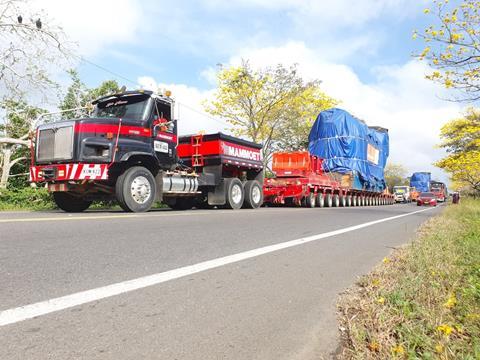Mammoet has transported 11 engines, weighing 287 tonnes each, to a remote location in San Antonio, Colombia, on behalf of freight forwarder UTC Overseas.

The engines were required for the construction of Celsia’s new 200 MW power plant. The isolated location of the site was chosen due to proximity to the gas source and to help bring jobs to the local area.
That isolation posed major problems for the client, which had initially considered receiving the engines at one of the region’s two main ports – Cartagena or Barranquilla. Edilber Guerrero, Mammoet sales manager, added: “At first, the client was thinking it wasn’t possible to transport the engines fully assembled to the jobsite. They were considering dismantling them into two pieces. With smaller pieces it is easier to transport, so this was their initial plan. Of course, the downside to this is that you would then need to build the engines on site, so you need more time, more people, more resources and money. The scale of the project would double.”
The public port of Compas in Tolu is closer to the jobsite but is typically used for loading and unloading coal vessels, not heavy lift cargo. Receiving the engines at Cartagena (the closer of the two main ports) added 100 km to the journey and further road restrictions.
Mammoet proposed the use of the port at Compas and an alternative route of secondary roads. This would allow the operation to be carried out more efficiently and with complete engines. The first challenge was to prove to the authorities that the port could receive the engines; of particular concern was the connection bridge between the quay and the land and whether it could handle the exceptional load. Mammoet engineers successfully carried out all the verifications to prove that the port and the bridge was suitable for the operation. The engines were then shipped from Europe on a single vessel to the location.
On arrival, they were transhipped, via crane, from the vessel onto conventional 20-axle line flatbed trailers with a prime mover and then transported to a holding area inside the port. From there, they were delivered, by road, to the site in convoys of three. The team had determined that the main highway would not be suitable due to the presence of towns (such as Sincelejo) and a 100 m-long bridge with insufficient load capacity. Therefore, they proposed an alternative route to bypass these restrictions.
This route comprised unpaved narrow roads. The roads were levelled and compacted, and vegetation trimmed back. Wire-relief teams were also used to lift and temporarily disconnect low-hanging cables.
One of the biggest challenges was transporting the heavy cargo across five weak bridges. Support ramps were installed to allow the convoy to travel safely across them without overloading. When the convoy eventually joined the national road, it entered populated urban areas and faced different challenges.
“We had to manage traffic, people and liaise with the local authorities to agree the exact times that we were going to cross the towns,” said Guerrero. “Coordination with the local communities became the challenge. In advance, we lifted as many of the cables and removed roadside obstacles, such as billboards, but there were still a few cables that had to be raised during transit.”
Moreover, the road leading to the jobsite had a small weak bridge, so steel columns were installed to reinforce it and allow the cargo to pass. Inside the site there was little space to manoeuvre, so the cargo was reloaded onto SPMTs to allow for tight turns and final positioning.
















